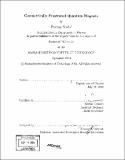Geometrically frustrated quantum magnets
Author(s)
NikoliÄ , Predrag, 1974-
DownloadFull printable version (12.01Mb)
Other Contributors
Massachusetts Institute of Technology. Dept. of Physics.
Advisor
Senthil Todadri.
Terms of use
Metadata
Show full item recordAbstract
(cont.) more general lessons on frustrated quantum magnetism. At the end, we demonstrate some new mathematical tools on two other frustrated two-dimensional systems, and summarize our conclusions, with an outlook to remaining open problems. In this thesis we attempt to reach a physical understanding and theoretical description of some of the greatest challenges in the field of frustrated quantum magnetism, mainly the Kagome lattice antiferromagnets. After an introductory review of concepts, we closely examine the Kagome lattice quantum Heisenberg and Ising models. We apply several new techniques based on lattice gauge theories, duality mappings and field theory in order to explore phase diagrams of these models. Our approach provides a microscopic picture of the mysterious phenomena observed numerically and experimentally in the Kagome Heisenberg antiferromagnets. Namely, we argue that the spinless excitations, thought to be gapless in absence of any symmetry breaking in this system, are in fact gapped, but at an extremely small emergent energy scale. This scenario is realized in an unconventional valence-bond ordered phase, with a very large unit-cell and complex structure. We also discuss properties of a spin liquid that could be realized in the Kagome antiferromagnet, and argue that its elementary excitations are clearly gapped and extremely massive or even localized. We demonstrate that the Kagome lattice quantum Ising models are an excellent platform for learning about effects of quantum fluctuations on classically degenerate ground-states. We consider several ways in which spins can acquire quantum dynamics, including transverse field, XXZ exchange and ring-exchange perturbations. Using two different setups of compact U(1) gauge theory we find circumstances in which many characteristic quantum phases occur: disordered phase, topologically ordered spin liquid, valence-bond crystal, and a phase with coexistence of magnetic and valence-bond order. From this variety of results we attempt
Description
Thesis (Ph. D.)--Massachusetts Institute of Technology, Dept. of Physics, 2004. Includes bibliographical references (p. 215-219).
Date issued
2004Department
Massachusetts Institute of Technology. Department of PhysicsPublisher
Massachusetts Institute of Technology
Keywords
Physics.